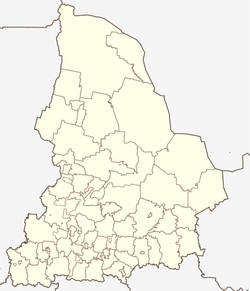Belojarsky (Sverdlovsk)
| Urban-type settlement
Belojarsky
Beloyarsky
|
||||||||||||||||||||||||||||||||||||
|
||||||||||||||||||||||||||||||||||||
|
||||||||||||||||||||||||||||||||||||
| List of large settlements in Russia | ||||||||||||||||||||||||||||||||||||
Belojarski ( Russian Белоя́рский ) is an urban-type settlement in the Sverdlovsk Oblast ( Russia ) with 12,615 inhabitants (as of October 14, 2010).
geography
The settlement is located in the west of the West Siberian lowlands , about 50 km as the crow flies east of the Oblast capital Yekaterinburg, mostly on the right bank of the Pyschma . The river is dammed a few kilometers above the village to the Belojarskoye reservoir , which mainly serves to supply the Belojarsk nuclear power plant on its eastern bank with cooling water .
Belojarski is the center of the urban district of the same name (previously Belojarski Rajon).
history
From 1686 or 1687 the boyars Tomilov from Verkhoturye founded around 20 villages in the area around the present-day settlement, which were grouped under the name Belojarskaja sloboda . The name is obviously derived from the Russian words jar for a steep river bank and bely , white for the light-colored rocks that emerge there. In 1695 an ostrog was built . Until 1700 the villages belonged to Ujesd Verkhoturje, then to Ujesd Tobolsk , from 1725 finally to Ujesd Yekaterinburg of the Perm governorate .
The importance of the settlement grew with the opening of the Siberian tract by the place in 1781. A good century later, in 1885 the Yekaterinburg - Tyumen railway line , which is now part of the Trans-Siberian Railway , passed by.
As part of an administrative reform, Belojarskoje, as the village was now called, became the administrative center of a newly created raion of the same name in 1924. In March 1927, the Rajon was renamed after the nearby railway station in Baschenowo, dissolved on September 20, 1933 and its area was subordinated to the city soviet Sverdlovsk - as Yekaterinburg was called since 1924. However, on May 26, 1937, Belojarskoye Raion was restored.
In 1954, the preparatory work for the construction of the Belojarsk nuclear power plant, not far from today's city of Zarechny , began on the territory of the Rajon , which also had an impact on the development of the village and the administrative center of the Rajon. On August 14, 1959, it received the status of an urban-type settlement under its current name. At the same time, the surrounding villages of Butakowo, Bolschaja and Baschenowo as well as some factory settlements were incorporated.
Belojarsky Rajon, which has been in its current form since December 17, 1995, after the city of Saretschny was spun off in 1992 and other changes, was transformed into an urban district as part of the administrative reform in Russia in 2007.
Population development
| year | Residents |
|---|---|
| 1939 | 1,412 |
| 1959 | 9,726 |
| 1970 | 12,669 |
| 1979 | 13,949 |
| 1989 | 13,711 |
| 2002 | 12,645 |
| 2010 | 12,615 |
Note: census data
Economy and Infrastructure
In Belojarsky there are forestry and wood processing industries, equipment manufacturing and the food industry, as well as a packaging factory.
The settlement is on the Trans-Siberian Railway ( Baschenowo station in the district of the same name a few kilometers southwest of the town center; route kilometers 1850 from Moscow ), from which a branch line branches off to the city of Asbestos . The R351 regional road from Yekaterinburg to Tyumen runs through Belojarski .
Individual evidence
- ↑ a b Itogi Vserossijskoj perepisi naselenija 2010 goda. Tom 1. Čislennostʹ i razmeščenie naselenija (Results of the All-Russian Census 2010. Volume 1. Number and distribution of the population). Tables 5 , pp. 12-209; 11 , pp. 312–979 (download from the website of the Federal Service for State Statistics of the Russian Federation)
- ↑ a b The story of Belojarsky on the Heraldry of Sverdlovsk Oblast website (Russian)
- ↑ a b Belojarsky on the website of the Geographical Institute of the RAN (Russian)



